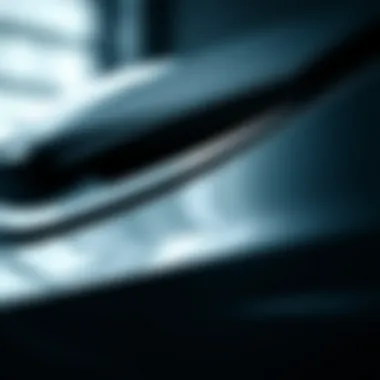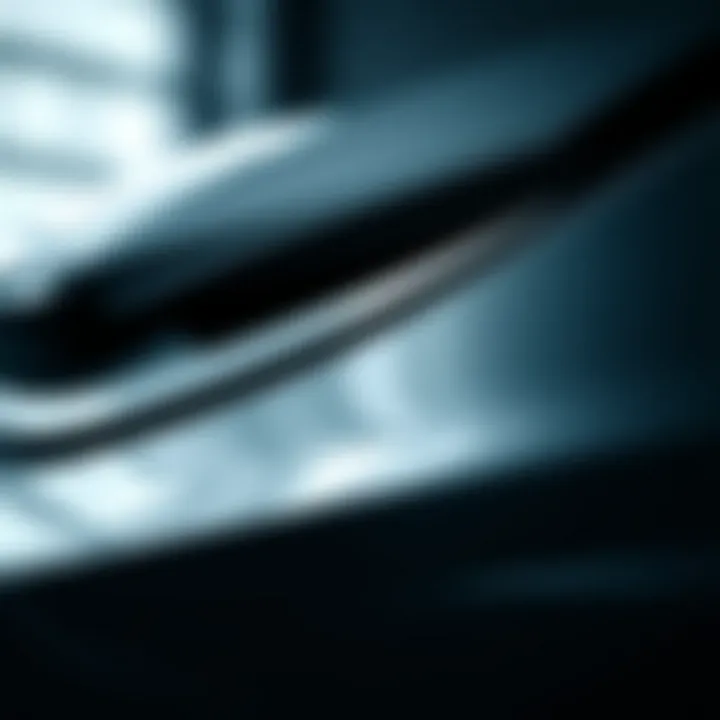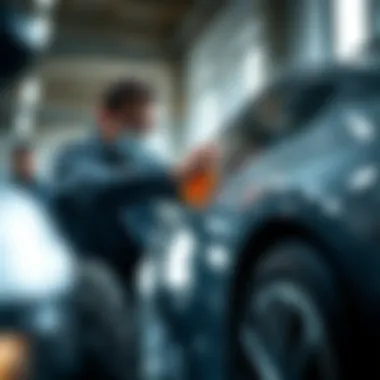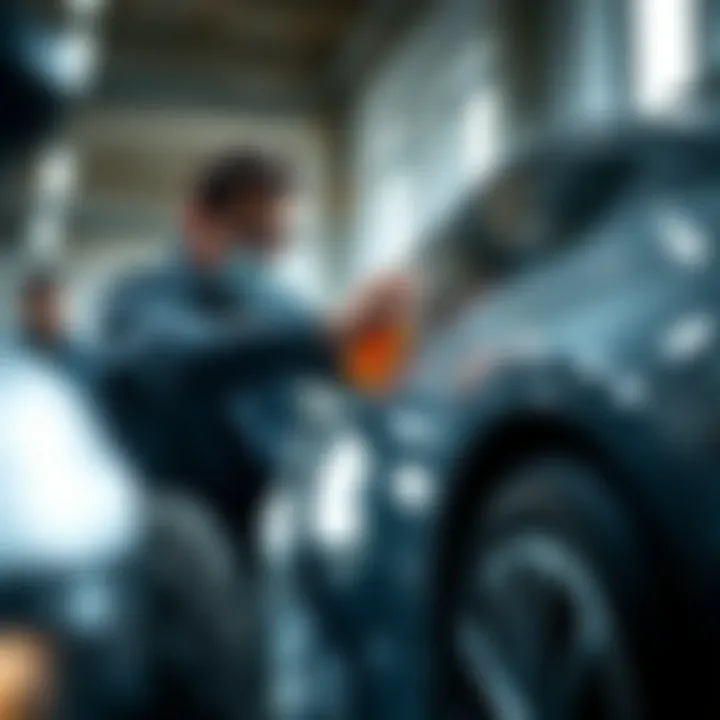Effective Ways to Remove White Scratches from Cars


Intro
White scratches on vehicle surfaces can be quite a nuisance for car owners. They can diminish the appearance of a vehicle, making it look worn and less valuable. Understanding the causes of these scratches is paramount. They often arise from a host of factors, from the natural wear and tear of a car's exterior to inadvertent mishaps like leaning a bicycle against the paintwork or minor run-ins with shopping cart.
Fortunately, there exist a plethora of strategies to combat this problem. Whether one opts for a do-it-yourself approach or seeks the expertise of a professional, it is essential to have an arsenal of effective methods on hand to restore a car’s aesthetic appeal.
In this guide, we will delve into the various tactics available for removing white scratches, equipping you with the knowledge needed to address these unwanted blemishes. From identifying the type of scratches to choosing the right products and techniques, this article intends to be a comprehensive resource for anyone looking to maintain their vehicle's beauty.
Market Research Overview
Industry Trends and Insights
The automotive care industry is steadily evolving as consumers become more informed about vehicle maintenance. The rising awareness regarding the importance of vehicle aesthetics has driven interest in scratch removal products and techniques. A significant portion of car owners now prioritize maintaining their vehicle's exterior to protect their investment.
Previously, many consumers might have overlooked minor scratches or assumed that professional help was the only available option. However, modern DIY solutions and innovative products have garnered attention. The market is now abuzz with various solutions tailored toward scratch removal, including polishing compounds, scratch repair pens, and ceramic coatings designed to provide long-lasting protection.
Consumer Demographics
The target audience for scratch removal products spans across diverse demographics but mainly consists of automotive enthusiasts, environmentally conscious individuals, and tech-savvy consumers. Younger generations, in particular, tend to favor DIY solutions that incorporate new technology. They are more inclined to research effective ways to enhance their cars without immediately seeking professional services. Car enthusiasts often engage on platforms such as forums or Reddit to share their experiences about the most efficient methods.
As car aesthetics continue to rise in importance for many, understanding how to effectively deal with scratches, such as those pesky white lines, isn’t just a trend; it’s becoming a necessary skill.
"Always remember that the first impression matters, and a well-kept vehicle speaks volumes about its owner."
This overview sets the stage for our discussion regarding the various strategies and methods available for tackling white scratches on cars. As we delve deeper, detailed analysis and expert advice will equip you with the tools needed to make educated decisions on maintaining the look and value of your vehicle.
Understanding White Scratches on Cars
When it comes to maintaining the appearance of a vehicle, understanding the problems that can arise is crucial. White scratches, for instance, can be more than simple cosmetic issues; they can reflect deeper problems with the vehicle's paint and finish. Ignoring these scratches may lead to further deterioration, making it essential for car owners to not only recognize their existence but also to understand how they occur and how to address them. This section lays the groundwork for effective strategies that can help keep your car's look fresh and polished.
Definition of White Scratches
White scratches are primarily superficial in nature, manifesting as light marks on the car's exterior paint, often exhibiting a whitish hue. These scratches usually occur when the paint from the vehicle is slightly scuffed or scraped - often due to contact with abrasive surfaces. Unlike deeper scratches that may penetrate the clear coat, white scratches typically involve only the uppermost layers of paint. For car enthusiasts and everyday drivers alike, recognizing the definition of these scratches is step one in the battle against paint damage. Their relatively shallow nature means they can often be addressed without needing specialized tools or professional intervention.
Common Causes of Scratches
Tree Branches and Bushes
Tree branches and bushes can be a sneaky foe when it comes to vehicle scratches. These natural elements often droop into parking areas or driveways, creating an environment ripe for scratches. Whether it's a drive under a low-hung branch or brushing against a bush, the result is the same - unsightly white scratches. The fact that they are common in both urban and rural areas makes them particularly pertinent to our discussion. With dense foliage often surrounding roadways, it's critical to be mindful of the positioning of trees and bushes, as they contribute significantly to the scratches on vehicle surfaces.
Car Wash Brushes
Another common culprit in the offending list is car wash brushes. While keeping a vehicle clean is undoubtedly essential, not all methods are created equally. Many automated car washes use brushes that, over time, can create micro-scratches on the paint, which ultimately surface as white imperfections. These brushes can trap dirt and grit from previous washes, compounding the problem with every clean. It’s often wise to consider a touchless wash or hand washing to prevent this kind of damage. Being aware of this potential hazard is key for all car owners who frequently use commercial car cleaning services.
Road Debris
Road debris is an ever-present risk for vehicle owners, whether it’s a small pebble kicked up by a passing truck or something larger. These flying objects can hit the car at high speeds, leading to scratches that might not be immediately noticeable but over time develop into more significant cosmetic damage. Not only regular preventive measures should be employed, but also vigilance while driving can greatly minimize encounters with stray debris. Understanding where and when these hazards are most prevalent is an invaluable aspect of maintaining vehicle aesthetics.
Identifying Surface Damage
Different Types of Paint Damage
Understanding the various types of paint damage is essential for addressing white scratches accurately. There are several categories of paint damage that drivers need to be aware of - from clear coat damage to deeper scratches that penetrate the color paint layer. Knowing the difference allows car owners to choose the right repair strategy, whether it’s a DIY solution for shallow scratches or seeking professional help for severe damage. Misidentifying the type of damage could lead to inappropriate treatment and, ultimately, a wasted effort.


Assessing Scratch Depth and Severity
Once the type of damage is identified, assessing the depth and severity of scratches is the next logical step. Light scratches can often be polished out, while deeper ones may require more involved techniques such as sanding and repainting. There’s a straightforward method car enthusiasts often use – running a fingernail over the scratch. If it catches or feels rough, it’s likely a deeper issue, while smooth scratches might indicate they are only superficial.
Being informed about the nature of these scratches sets the stage for employing effective strategies to address and eliminate them. With the right knowledge at hand, car owners are better equipped to maintain their vehicle's appearance and prolong its lifespan.
Initial Assessment of Damage
Assessing damage is a pivotal step in addressing white scratches on your car's surface. Quite frankly, jumping straight to fixes without first understanding the extent and type of damage might lead to ineffective solutions or, worse, exacerbate the problem. An informed approach not only saves time and money but also ensures that the best possible outcome is achieved – something every car owner can appreciate.
These initial assessments help to clearly define the path forward, whether that’s taking the DIY route or reaching for professional assistance. The benefits of rigorous damage evaluation extend beyond mere aesthetics; they touch on long-term vehicle health and resale value. A well-maintained finish means your car can hold its value longer, which is something all owners ought to keep in mind.
Visual Inspection Techniques
Proper visual inspection begins by finding a well-lit area where you can scrutinize every inch of the vehicle’s surface closely. Look at different angles, as light can often reveal scratches that are otherwise hidden. When assessing scratches, consider these points:
- Identify Scratch Type: Is it a surface scratch, or does it cut deeper into the paint?
- Location Matters: Scratches on horizontal surfaces may receive more sunlight and thus, worsen quicker compared to those on vertical surfaces.
- Color Integrity: Do the hues look consistent across the scratched area? Changes in color could indicate deeper damage to the clear coat.
Using a magnifying glass can be a handy tool in this part of the assessment. Tiny details can inform the method you'll choose later on. Don't forget to document the findings - a simple note or photo can help you track progress as you make repairs.
Using a Touch-Up Paint Test
Once you've assessed the scratches with a visual inspection, a touch-up paint test can offer further clarity on the damage's seriousness. This is particularly useful for scratches that you suspect might not be as deep as they appear. Here’s how to execute this test effectively:
- Clean the Area: Before applying any paint, ensure the scratched region is clean and free of dirt or grease. This allows for a smooth application.
- Select the Right Paint: Use a compatible touch-up paint that closely matches your car’s color code. This info can usually be found on the inside of the driver’s door.
- Apply a Small Amount: With a fine brush, carefully apply a small amount of paint directly into the scratch. It’s better to start with less than more, as paint can always be added but is trickier to remove.
- Evaluate Coverage: After the paint dries, assess how well it covers the scratch. If the damage is still visible, it may require a professional's skill to restore the finish fully.
This method serves two key purposes: it not only helps determine the severity of the damage but also provides a temporary fix. Touch-up paint can give your car a fresh look and protect the underneath layers from further harm until more extensive repair can be performed.
DIY Methods for Scratch Removal
When it comes to getting rid of white scratches on your car, DIY methods can be instrumental. They are not only cost-effective but also empower car owners to take restorative actions into their own hands. What’s more, these strategies allow for quicker responses to minor scratches without the need for professional intervention, making them quite appealing for the everyday vehicle owner. While there are plenty of professional solutions available, knowing how to handle these blemishes at home is a practical skill that can enhance your car's longevity and aesthetic appeal.
Using Toothpaste as a Scratching Agent
Toothpaste, specifically the kind that has baking soda in it, can actually work wonders on minor scratches. Apply a small amount to a soft cloth and rub it gently in a circular motion over the scratch. The mild abrasives in the toothpaste act on the scratch, helping to smooth it out. However, patience is key. While it may not make the scratch vanish entirely, it can help blend it with the surrounding area significantly. After some minor elbow grease and a thorough wipe down, you'll see an improved look.
Applying Baking Soda Paste
Baking soda is one of those household items that proves its worth when it comes to minor car repairs, too.
- Mix two parts baking soda to one part water to form a paste.
- Use a soft cotton cloth to apply the mixture on the scratches.
- Gently rub it in a circular motion and then clean off with water.
This method harnesses the slight abrasiveness of baking soda to level out the surface, while also acting as a cleaner. Just be sure to wash off any remnants afterward, as leaving the paste could attract more dirt.
Utilizing Rubbing Compound
Rubbing compound is often an unsung hero in the scratch removal world. This method can yield dramatic results if applied properly.
Step-by-Step Application
- First, ensure the car's surface is clean. Dirt can exacerbate the problem!
- Choose a soft applicator pad and apply a small amount of rubbing compound onto it.
- Working in small sections, rub the compound over the scratched area using a back-and-forth motion. The idea here is to gently work the compound into the scratch to reduce its visibility.
- Wipe off any excess with a clean cloth to review your work.
The versatility of this method is its key characteristic; many car detailing enthusiasts swear by it. It’s effective and relatively simple, though one should remember that it’s designed for those who can dedicate a bit of time and effort.


Safety Precautions
Taking safety precautions while using rubbing compound ensures the job is done smoothly without accidents. Always use protective gloves to shield your skin from harsh chemicals. Additionally, make sure to work in a well-ventilated area to avoid inhaling any fumes. Those precautionary measures highlight the importance of maintaining safety while working on your vehicle. While this is a simple process, neglecting basic safety can lead to avoidable issues, making it an essential consideration. Protecting yourself enhances not only your ability to effectively work on your car but also maintains a pleasant atmosphere during the process.
Using Paint Sealant for Minor Scratches
After you’ve dealt with the scratches, applying a paint sealant can help protect your vehicle from future damage. Paint sealants provide a protective layer over the existing surface, acting as a barrier against environmental contaminants. Applying a thin layer will enhance the car's shine while also filling in and disguising smaller scratches that might still be noticeable after treatment. This step could make all the difference in preserving that freshly polished look.
Professional Techniques for Severe Damage
When it comes to addressing severe scratches on your car, relying solely on DIY methods can often fall short. Professional techniques are essential in these situations, particularly when dealing with significant surface damage that requires specialized knowledge and equipment. Hiring an expert not only ensures the correct treatment for the specific type of scratch but also prevents the risk of causing further damage to your vehicle’s paintwork. It's about looking after your investment and ensuring that you leave no stone unturned in restoring your car's aesthetic appeal.
When to Seek Professional Help
Determining when to seek professional help can be tricky. Here are some pointers to help you make that decision:
- Depth of the Scratch: If you can feel the scratch with your fingernail, it’s often a sign that it has penetrated the clear coat. At this point, a DIY fix might not do the trick.
- Extent of Damage: Multiple scratches, deep gouges, or widespread damage typically warrant professional intervention. Assess whether the scratch is isolated or if it’s part of a larger picture of wear and tear.
- Time and Effort: If you don’t have the time or tools required for an effective repair, it might be wise to engage a professional instead. They can save you from headaches down the line.
"A stitch in time saves nine". The sooner you address that scratch, the less chance it has to worsen.
Paint Correction Services
If you're dealing with severe scratches, paint correction services are often your best bet. Professional services utilize advanced techniques that go beyond your average scratch remover methods. Some effective tools and techniques in this realm include:
- Machine Polishing: This process involves the use of machines that can polish away layers of the paint surface to eliminate scratches. It’s efficient and can restore your car's original shine.
- Compound Application: Specialized compounds are designed to gently abrade the surface layers to smooth out imperfections, while also bringing back that gloss.
- Ceramic Coatings: Post-correction, many professionals recommend applying a ceramic coating for added protection. This not only keeps the paint looking pristine but also provides a robust shield against future scratches.
Respraying Damaged Areas
In certain cases, deep or extensive scratches might necessitate a complete respray of the afflicted area. This is especially relevant if:
- Color Matching is Critical: Ensuring that the new paint matches the existing hue perfectly can be challenging. Skilled professionals have the ability to match paint not only to the color but also to the possible fade or wear from exposure.
- Large Areas are Affected: For multiple scratches that disrupt the aesthetics significantly, respraying can provide a unified look and feel, making it seem like the car just rolled off the assembly line.
- Repair Versus Replacement: Respraying can sometimes be more cost-effective than replacing unintentionally damaged parts, particularly when those parts can be restored to their original state with proper techniques.
In sum, while the do-it-yourself route can work for minor imperfections, severe scratches often require the expertise of professionals to truly bring your vehicle back to its former glory. From paint correction to respraying, understanding your options is key to ensuring that your car maintains its appearance and value.
Preventive Measures for Vehicle Care
Preventive measures are often the unsung heroes in the maintenance saga of your vehicle. By taking proactive steps, you're not only preserving your car’s glossy finish but also enhancing its overall value. Preventive care can save a world of trouble down the line, turning what could be a costly repair into simple upkeep. It's all about minimizing exposure to factors that lead to those pesky white scratches.
Regular Washing and Waxing
Regular washing is like the daily skin routine for your car. Dust, dirt, and pollutants build up and can cause scratches if not tended to. Moreover, when you wash your car routinely, you remove external contaminants that could potentially damage the paint. A good rule of thumb is to aim for a wash every two weeks, especially if you drive in rural areas or near construction sites where debris is more prevalent.
Don’t skimp on the waxing, either. Waxing creates a protective barrier over your paint and offers additional luster and shine. Think of wax as sunscreen for your vehicle; it blocks harmful UV rays and helps guard against corrosion. A high-quality car wax keeps the surface slick, making it more difficult for scratches to adhere. So, invest in a good wax and keep your car looking sharp.
- Tip: Choose a soft microfiber cloth when drying your car to further reduce the risk of scratches.
- Remember: Both washing and waxing only work effectively if done correctly, so avoid rough scrubbing or cheap, abrasive materials.
Using Protective Coatings
This step is like armor for your vehicle’s finish. Protective coatings go beyond traditional wax and provide long-term protection from scratches, UV rays, and environmental damage. There are a few options available on the market like ceramic coatings and paint sealants that bond with the vehicle's surface, offering durability that lasts years.
Ceramic coatings are particularly popular and provide a hard layer of protection. They resist chemical stains and make cleaning easier, as dirt and grime are less likely to stick. This means fewer washes and less chance for scratches to form over time.
Keep in mind that while these coatings can be on the pricier side, the investment is often worth it when you consider the defense they provide against potential damage.


- Important: Always consult with a professional before applying long-term coatings to ensure proper application.
- Consider: How frequently you drive and the environment your car is exposed to will affect your coating choice.
Parking Practices to Avoid Scratches
The location where you park your vehicle plays a surprisingly significant role in the health of your car’s finish. Avoiding reckless parking not only minimizes the risk of scratches but also reduces the likelihood of collisions. Here are a few strategies:
- Find Covered Parking: Parking in a garage or under a carport keeps your vehicle shielded from the elements and reduces tree sap or bird droppings that can etch into your paint.
- Be Mindful in Public Spaces: If you must park on the street or in a busy lot, try to position your vehicle away from heavy traffic and potential dangers. Park further away from shopping cart returns, for instance, to avoid random bumps from carts.
- Use a Car Cover: If you’re leaving the car outside for longer periods, consider investing in a high-quality car cover. It can act as a barrier against dust, scratches, and UV rays from the sun.
All of these efforts may seem like minor details, yet they accumulate over time and have a substantial impact on maintaining your vehicle's pristine aesthetic. Take to heart the notion that an ounce of prevention is worth a pound of cure, especially when it comes to your car’s finish.
Remember, with careful attention to these preventive measures, white scratches can become a thing of the past, preserving not just your car's look but also its overall longevity.
Maintaining Aesthetic Appeal Post-Repair
Addressing white scratches on your vehicle is only part of the journey toward achieving an impressive finish. Just as a painter would carefully evaluate their canvas before applying the final brush strokes, maintaining the aesthetic appeal after repairs is crucial. Not only does this keep your car looking sharp, but it also safeguards its resale value. A well-kept exterior reflects care and attention, which can be a significant advantage when potential buyers come knocking.
Choosing the Right Wax and Sealant
After successfully tackling those unsightly scratches, the next step involves a layer of protection. Selecting the appropriate wax and sealant is akin to dressing your car in a protective armor. A high-quality wax can enhance the car’s shine, while sealants provide a longer-lasting barrier against elements such as dirt, UV rays, and minor abrasions. Both products serve to maintain that freshly-repaired look, ensuring your vehicle remains as dazzling as the day you rolled it out of the showroom.
There are various types of waxes and sealants available, but not all are created equal. Consider ingredients like Carnauba wax for its deep shine and natural protection, or synthetic sealants for durability and longevity. Here are a few points to guide your choice:
- Formulation: Look for products with natural ingredients for a richer finish or synthetic options for enduring protection.
- Application Method: Some products may require more prep work or specific application tools, so read up on compatibility with your existing maintenance routine.
- Longevity: Check reviews or manufacturer claims about how long each product maintains its protective qualities.
Routine Inspections for New Scratches
Even with the best protective products, it wouldn't hurt to do a double-take now and then. Regular inspections can be your best friend in the battle against new scratches. This proactive approach allows you to catch issues before they escalate—like finding that scratch before it turns into a rust problem. Set a schedule that works for you—be it weekly or monthly—and incorporate this into your vehicle care routine.
When inspecting, consider the following tips:
- Lighting: Inspect in daylight; artificial lights can hide or distort damage.
- Touch and Feel: Run your fingers over the surface to detect rough areas that may warrant attention.
- Quality Over Quantity: Too frequent inspections can lead to burnout. Ensure your focus remains effective without becoming a chore.
"An ounce of prevention is worth a pound of cure." This adage rings true when it comes to vehicle maintenance. By choosing the right wax and performing routine inspections, you can keep your car looking sharp and well-cared for.
Ending and Final Thoughts
In closing, addressing the issue of white scratches on cars is not merely a cosmetic endeavor; it aligns with maintaining the vehicle's overall integrity and value. A clean, well-cared-for car not only boosts pride of ownership but also retains higher resale value. As covered throughout this article, understanding the nature of scratches and their causes lays down the groundwork for effective correction methods. Each strategy discussed, from DIY remedies to professional interventions, holds significance depending on the severity and extent of the damage.
Key considerations include:
- Choosing the right method based on the depth and visibility of scratches.
- Regularly inspecting your vehicle's exterior to address scratches early before they escalate.
- Committing to ongoing vehicle maintenance by utilizing protective coatings and proper washing techniques to prevent future occurrences.
"An ounce of prevention is worth a pound of cure." The same applies here; small efforts in upkeep can save substantial time and effort in repairs later.
By fostering an active approach to vehicle care and utilizing the strategies provided, car owners can effectively manage and eliminate those pesky white scratches when they arise. The culmination of the knowledge provided empowers you to not just fix what's broken but to take proactive steps in preserving your car's beauty and function over time.
Summary of Key Points
The main takeaways from our exploration into eliminating white scratches from cars include:
- Understanding Scratches: Recognizing what causes scratches aids in reinforcing the vehicle's defense against future scratches.
- Assessment: Knowing how to evaluate paint damage can lead to a more informed approach in selecting remedies, whether DIY or professional.
- DIY Techniques: Simple household materials can be surprisingly effective at removing minor scratches, providing immediate and accessible solutions.
- Professional Solutions: There are circumstances where professional assistance is necessary, particularly for severe scratches that DIY methods cannot resolve.
- Preventive Maintenance: Regular care, including washing and applying sealants, plays a crucial role in prolonging the life of your vehicle’s paintwork.
Encouragement to Practice Proper Vehicle Maintenance
Finally, it cannot be overstated how vital it is to cultivate a habit of taking care of your vehicle. Think of your car as an investment that deserves respect. Practicing proper maintenance means being proactive rather than reactive. Not only does regular washing help maintain that showroom shine, but it can also prevent dirt and grime from embedding into scratches, making them harder to remove later.
Moreover, consider investing in quality car waxes and sealants. Tools like a microfiber cloth and soft brushes can make a world of difference in your cleaning routine.
In essence, vehicle care is an ongoing journey, one where every small effort contributes to achieving and sustaining aesthetic appeal. Embrace the methods discussed in this article with intentionality, and your vehicle will certainly thank you for it in the long run.







